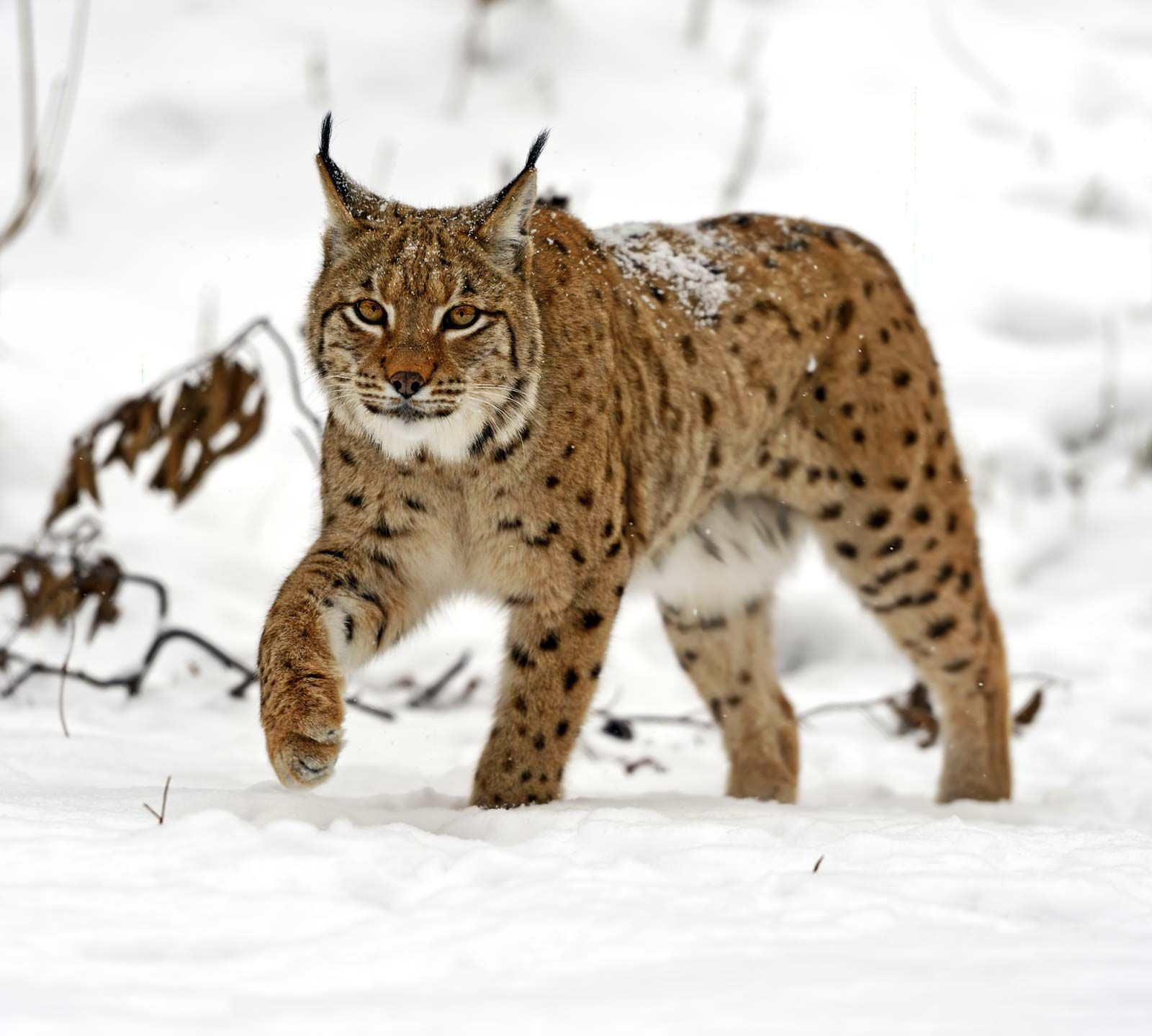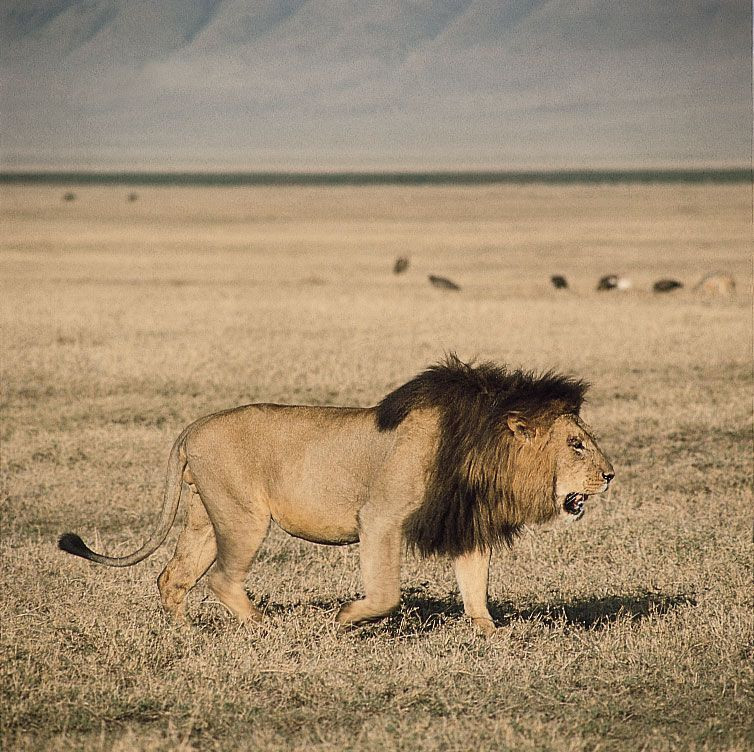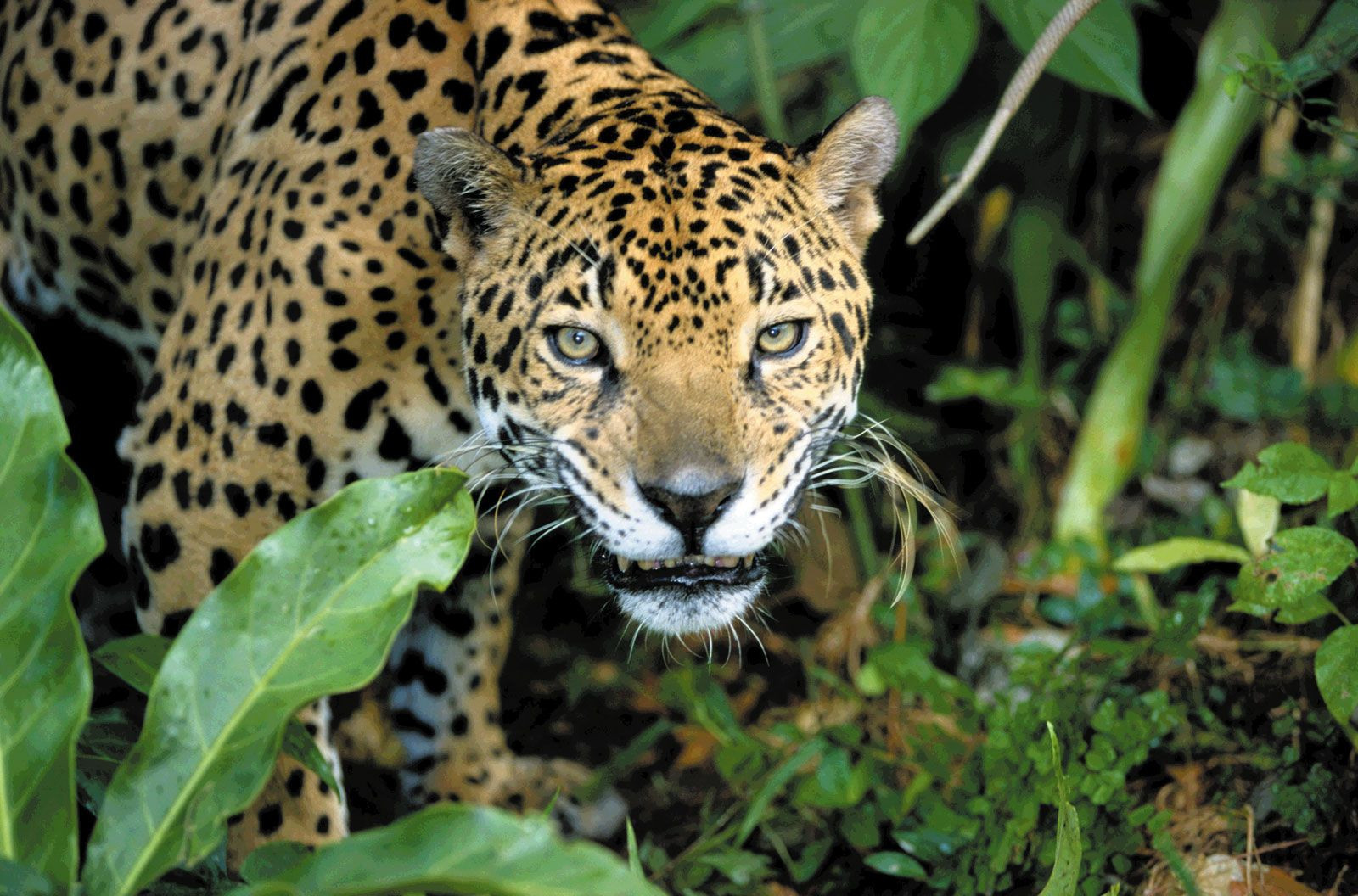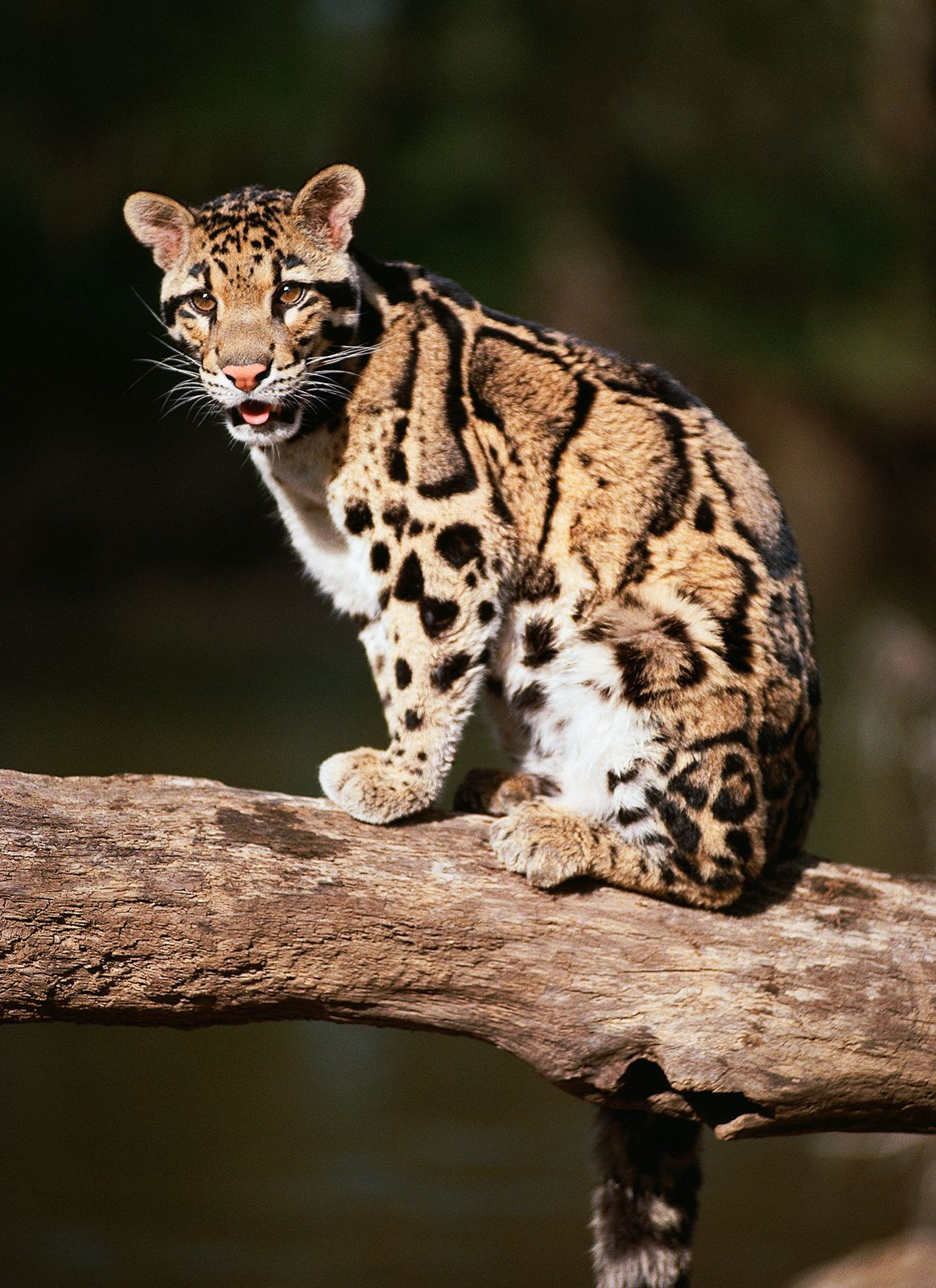The feline family, scientifically known as Felidae, encompasses a fascinating array of 37 cat species that roam across our planet. From the familiar domestic cat purring on our laps to the majestic lions ruling the African savanna, the diversity within the cat family is truly remarkable. These carnivorous mammals, found in nearly every corner of the globe except Australia and Antarctica, exhibit a captivating blend of shared traits and unique adaptations. Understanding “Cats In The Cat Family” means delving into the world of Felidae, exploring their evolution, characteristics, and the critical roles they play in various ecosystems.
 Eurasian lynx in its natural habitat
Eurasian lynx in its natural habitat
What Defines a Cat? Key Characteristics of the Feline Family
Members of the cat family share several defining characteristics that set them apart as exceptional predators. Their bodies are meticulously crafted for hunting, showcasing features that range from physical attributes to behavioral patterns. These shared traits are fundamental when discussing “cats in the cat family”.
One of the most notable features of felines is their physical build. Most cats possess a lithe and muscular body, designed for agility and power. They typically have a short face and a rounded head, often adorned with relatively short ears. While most cats boast long tails, approximately a third of their total body length, the lynx species presents an exception with its characteristically stubby tail. Coat patterns are highly variable within the Felidae family. While some cats like pumas, jaguarundis, and lions display a uniform coloration, the majority are patterned with distinctive spots, stripes, or rosettes, providing excellent camouflage in their natural habitats. Intriguingly, melanism, resulting in black or near-black coats, occurs across several feline species. Sexual dimorphism is also common, with males generally larger than females in most cat species. A striking example is the male African lion, instantly recognizable by its impressive mane, a feature unique among felines that serves to enhance its visual size and potentially intimidate rivals or attract mates.
Retractile claws, except in the cheetah, are a hallmark of the cat family. These sharp claws are essential tools for hunting, climbing, and defense, remaining sheathed when not in use to maintain their sharpness. Furthermore, felines are renowned for their sensory acuity. They possess exceptional vision and hearing, crucial for nocturnal or crepuscular hunting strategies. Their sensitive whiskers (vibrissae) on the face play a vital role in navigation, particularly in low-light conditions, helping them perceive their surroundings and avoid obstacles silently while stalking prey.
Behaviorally, “cats in the cat family” are known for their distinctive vocalizations. While purring signifies contentment, they communicate a range of emotions through snarling, howling, hissing, and, in the case of “big cats” like lions, roaring and growling. However, for the most part, cats are stealthy and silent creatures, enhancing their predatory prowess. The habit of “clawing trees” is another intriguing feline behavior. Cats utilize trees and other surfaces to scratch, leaving claw marks. This behavior, observed even in isolated kittens, could serve multiple purposes, including claw maintenance, scent marking, or simply stretching.
 Male lion with a prominent mane
Male lion with a prominent mane
Diversity Within the Cat Family: From Big Cats to Small Felines
The Felidae family is broadly categorized into two main subfamilies: Pantherinae (big cats) and Felinae (small cats). This division, while useful, is not strictly based on size but also on genetic and anatomical differences, particularly in the hyoid bone structure which allows “big cats” to roar. Exploring this diversity is key to understanding “cats in the cat family”.
Pantherinae, the “big cats,” includes iconic species like lions, tigers, jaguars, leopards, and snow leopards. These cats are generally larger and more robust than their Felinae counterparts. They are apex predators in their respective ecosystems and often play significant roles in cultural symbolism and conservation efforts. Lions (Panthera leo), famed for their social nature, live in prides and are found in Africa and India. Tigers (Panthera tigris), the largest cat species, are solitary and inhabit Asian forests. Jaguars (Panthera onca), powerful and adaptable, are native to the Americas. Leopards (Panthera pardus) are incredibly versatile, thriving in diverse habitats across Africa and Asia.
Felinae, the “small cats,” comprises a larger group with diverse genera like Lynx, Puma, Leopardus, and Prionailurus. This subfamily includes familiar species such as domestic cats, lynx, pumas (cougars or mountain lions), ocelots, servals, and many others. Despite being termed “small cats,” some Felinae members, like the puma (Puma concolor), are still considerably large and powerful predators. Lynx (Lynx genus), adapted to colder climates, are found in North America, Europe, and Asia. Ocelots (Leopardus pardalis) are beautifully spotted cats of the Americas. Servals (Leptailurus serval) are slender, long-legged cats native to Africa. Even the smaller members of Felinae, like the flat-headed cat (Prionailurus planiceps) and fishing cat (Prionailurus viverrinus), exhibit specialized adaptations to their environments and diets.
 Jaguar in a rainforest environment
Jaguar in a rainforest environment
Natural History and Behavior: Hunting, Diet, and Reproduction
The natural history and behavior of “cats in the cat family” are as diverse as the species themselves, yet some common threads weave through their lives. From hunting strategies to social structures and reproductive habits, felines exhibit fascinating adaptations.
Hunting and Diet: As obligate carnivores, cats are primarily hunters, with diets ranging from small mammals and birds to large herbivores like deer and antelope. Their hunting techniques rely heavily on stealth, vision, and hearing. Typically solitary hunters, cats utilize their padded feet to approach prey silently. Their exceptional eyesight, particularly in low light, and sensitive hearing allow them to detect prey effectively. The final attack is usually a swift rush or leap, overwhelming prey with speed and powerful bites, often directed at the neck to dispatch prey quickly. While capable of short bursts of high speed, cats are not built for sustained chases, except for the cheetah (Acinonyx jubatus), which is renowned as the fastest land mammal, reaching speeds exceeding 100 km/h (62 mph) in pursuit of prey. Some cats, like the fishing cat, have adapted to aquatic prey, feeding on fish and crustaceans. Interestingly, the flat-headed cat is known to supplement its diet with fruits and sweet potatoes, a rare instance of vegetation consumption in the cat family. Larger cats often exhibit food caching behavior, storing kills in trees or under bushes after an initial feeding, allowing them to survive periods of food scarcity. Their feeding pattern is often described as “feast-or-famine,” gorging themselves after a successful hunt and then fasting for several days until the next kill.
Social Behavior and Reproduction: Social structures vary significantly within “cats in the cat family.” Most cats are solitary creatures, except for lions, which are notably gregarious, living in prides. Prides can consist of up to 30 individuals, typically comprising related females and their offspring, along with a few adult males. Reproduction in cats generally involves a gestation period of about two months for smaller cats and closer to four months for larger cats. Litter sizes typically range from one to six kittens. Female cats possess multiple nipples (four to eight) to nourish their young. Breeding seasons are often in late winter or early spring, although some species, like lions, tigers, and leopards, can breed year-round. Many cat species are induced ovulators, meaning ovulation is triggered by mating. Interestingly, size does not seem to dictate litter size, breeding frequency, or breeding season timing. However, larger cats tend to reach sexual maturity later than smaller cats. Kittens are usually born in secluded locations, such as rocky crevices, under fallen logs, or dense thickets. In most species, males do not participate in raising the young and may even pose a threat to kittens. The mother cat is solely responsible for the care and protection of her offspring.
 Clouded leopard perched on a branch
Clouded leopard perched on a branch
Conservation and the Future of Cats in the Cat Family
Despite their adaptability and widespread distribution, many “cats in the cat family” face significant threats in the modern world. Habitat loss, human-wildlife conflict, and illegal hunting for the fur trade pose serious dangers to numerous feline species. Conservation efforts are crucial to ensure the survival of these magnificent creatures.
The fur trade has historically driven the exploitation of many cat species, particularly those with striking coat patterns. Demand for furs with spots and stripes has led to illegal hunting and trapping, pushing some rare cats to the brink of extinction. While regulations exist in some regions, like North America, to manage sustainable harvesting of species like lynx, bobcats, and pumas, illegal poaching remains a pervasive threat globally. Habitat loss due to deforestation, agricultural expansion, and urbanization is a primary driver of decline for many cat populations. As human development encroaches on wildlands, cats lose their hunting grounds and face increased conflict with humans and livestock. Human-wildlife conflict arises when cats prey on livestock, leading to retaliatory killings by farmers and ranchers. Conservation efforts are multifaceted, including habitat protection and restoration, anti-poaching measures, community-based conservation programs, and research to understand cat ecology and behavior better. Protecting “cats in the cat family” is not just about preserving individual species; it is about maintaining the health and balance of entire ecosystems where these apex predators play vital roles.
Conclusion: Appreciating the Feline Family
“Cats in the cat family” represent a remarkable group of animals, showcasing evolutionary success and ecological importance. From the smallest domestic cat to the largest tiger, Felidae members captivate us with their beauty, power, and adaptability. Understanding their characteristics, diversity, and the challenges they face is crucial for fostering appreciation and inspiring conservation action. By recognizing the intrinsic value of “cats in the cat family” and supporting efforts to protect them, we can ensure that future generations will continue to marvel at these magnificent creatures in the wild.
